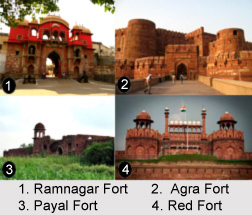Early History of Forts in India
The ancient treatises on Indian architecture and fortification can be retrieved from the 'Shilpa Shastras' and in some of the ancient Indian literature like the Indian Puranas and epics. This vast pool of knowledge gives a significant account of the development of the forts in India. 'Pur', a word which is mentioned repeatedly in the Vedas, means a rampart, fort or stronghold. Kautilya, in the forth century BC, wrote extensively regarding the protective fortifications. He differentiated forts as per the preferred types of site. The Nara Durg, a fort which was protected by men, gives an account of the Aryans correlation of a fort with a town.
 Medieval History of Forts in India
Medieval History of Forts in IndiaAfter the invasion of the Muslims, construction of forts in India reflects many of the developments which took place in Europe. The central citadel was kept isolated and secure from the expansive outwork of curtain walls. Usually the citadel was sited on a naturally defensible outcrop of rock. The forts of the great Maratha Emperors of western India like the Purandhar, Raigarh and Sinhagarh have manipulated natural terrain to their strategic advantage. At Gulbarga, in Deccan, the central stronghold followed the practice of the Crusader castles of the Near East, with a robust donjon or inner redoubt at the heart of the defence.
For more visit the page: https://www.indianetzone.com/43/forts_india.htm
